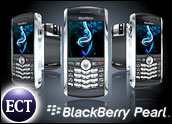
Mobile phone carrier Sprint Nextel announced plans Wednesday to offer the BlackBerry Pearl 8130, the latest Pearl from smartphone maker Research In Motion (RIM), in November. It is one of four handsets from Sprint that will make their debut in the coming weeks.
The addition of the Pearl will give Sprint users the “complete BlackBerry smartphone experience,” including new multimedia and communications capabilities for both business and personal users, according to Sprint.
“The Pearl 8130 is the best BlackBerry candy bar form factor ever launched by Sprint,” said Danny Bowman, vice president of customer equipment for Sprint. “Operating on the Sprint Mobile Broadband Network, the BlackBerry Pearl 8130 combines advanced smartphone features in an innovative design so customers can leave the laptop behind and live large, all at SprintSpeed.”
The Sprint announcement comes just in time for the holiday season and follows Verizon’s announcement last week that it will offer the Pearl 8130 as part of its autumn releases.
New Pearls for Sprint
Amethyst in color, the candy bar style Pearl is a fit for the average consumer as well as the business user, Bill Hughes, an analyst at InStat, told TechNewsWorld.
“The 8130 is targeted at prosumers, as are all the Pearls,” he explained. “I consider this a hybrid between a consumer device that is ‘just a phone’ but really does have the BlackBerry capabilities.”
That core functionality includes calendar management, access to personal and corporate e-mail as well as the ability to view documents.
This latest version of the Pearl will mark a first for Sprint in that it is the only BlackBerry the carrier has offered that takes full advantage of Sprint’s Sprint Power Vision Services. Users can download stereo quality tracks over the air (OTA) from thousands of artists in the Sprint Music Store. They can also watch live TV on one of more than 50 live television channels via Sprint TV or check out video-on-demand (VOD) with sound. In addition, OnDemand, a customizable service, will get users up to speed on the latest news, sports, weather, entertainment and movie trailers without slowing down.
In a first for the Pearl line, the smartphone also includes GPS functionality, available through Sprint Navigation. It offers users voice-guided and on-screen turn-by-turn driving directions, 3-D moving maps — more common to in-car and personal navigation systems. Also included are local search, real-time intelligent traffic alerts and one-click rerouting wherever the Sprint Mobile Broadband Network is available.
Other goodies include a 2-megapixel camera/camcorder with an enhanced flash for taking pictures and recording video, enhanced background noise cancellation, an external microSD/SDHC memory card for additional storage, stereo Bluetooth support and an improved media player and desktop media manager.
No pricing details have been released yet, but the device will be available at Sprint’s online and brick-and-mortar locations as well as through Sprint telesales and Sprint business sales channels.
Pearls Duke It Out
Billed as one of the “smallest and lightest smartphones in the world,” according to RIM, the Pearl 8130 comes just one year after the launch of the original Pearl, the 8100. Hughes, who owns the older model, said he found using the Pearl’s keyboard much more difficult than using a QWERTY keyboard. However, it’s much easier than using a numeric keypad to type out text.
“This means that moving up to a Pearl is easier than moving from another smartphone,” he noted.
The major additions featured in the newer 8130 are GPS and CDMA network capabilities. The devices come in at roughly the same length, width and depth, but the 8130 does weigh 0.3 of an ounce more than the 8100.
RIM has given the 8130 a 3.5mm stereo headset capable jack, and the device is rated at M3 and T3 for hearing aids. Standby times have declined on the latest model, dropping from 15 days to nine days, while talk time has improved from 210 minutes to 220 minutes.
With both Sprint and Verizon offering the Pearl 8130, mobile users not tied down to either carrier will find that there is no difference between the offerings of each network provider, Hughes pointed out.
“Ignoring the differences between the Verizon and Sprint networks, in terms of coverage and 3G deployments, there would be no difference,” he said. “Put another way, where both carriers have 3G coverage, service would be comparable. If one has 3G coverage and the other does not, there would be difference there.”
“Verizon has more cell sites/coverage, but that is a constantly changing story,” he added.




















































